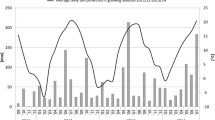Abstract
In 1999, a serious outbreak of Fusarium head blight occurred in durum wheat crops on the Liverpool Plains of northern New South Wales. Disease incidence in individual crops ranged from 2 to 100%. Gibberella zeae was the predominant pathogen. Analysis of weather records showed that in 1999, wheat flowered in an unusually wet and warm spring thus suggesting weather as a prime factor in the disease outbreak. A field survey showed disease incidence was linked to previous cropping history (particularly maize). Cultivar reaction to the disease was evaluated in a field trial. The durum cultivars Wollaroi and Yallaroi were more susceptible than currently recommended bread wheat cultivars. Seed fungicide dressings and seed grading treatments were evaluated in a series of experiments. Specific gravity grading and carboxin plus thiram seed dressing treatments gave the highest germination and emergence of seed. Carboxin plus thiram was the most effective treatment in reducing G. zeae carryover in seed but did not eliminate it.
Similar content being viewed by others
References
Boosalis MG, Doupnik BJ Jr, Wysong DS, Watkins JE (1983) The wheat scab epidemic of 1982. Farm. Ranch and Home Quarterly 29, 7–9.
Booth C (1973) ‘Gibberella zeae.’ CMI Descriptions of Fungi and Bacteria No. 384.
Burgess LW, Klein TA, Bryden WL, Tobin NF (1987) Head blight of wheat caused by Fusarium graminearum Group 1 in New South Wales in 1983. Australasian Plant Pathology 16, 72–78.
Burgess LW, Liddell CM, Summereil BA (1988) ‘Laboratory manual for Fusarium research (2nd edn).’ (University of Sydney: Sydney, Australia)
Dill-Macky R, Jones RK (2000) The effect of previous crop residues and tillage on Fusarium head blight of wheat. Plant Disease 84, 71–76.
Fernando WGD, Miller JD, Seaman WL, Seifert K, Paulitz TC (2000) Daily and seasonal dynamics of airborne spores of Fusarium graminearum and other Fusarium species sampled over wheat plots. Canadian Journal of Botany 78, 497–505.
Gilbert J, Tekauz A (1995) Effects of fusarium head blight and seed treatment on germination, emergence, and seedling vigour of spring wheat. Canadian Journal of Plant Pathology 17, 252–259.
Goldstein H, Healy MJR (1995) The graphical presentation of a collection of means. Journal of the Royal Statistical Society A 158, 175–177.
Jacobsen BJ, Harlin KS, Swanson SP, Lambert RJ, Beasley VR, Sinclair JB, Wei LS (1995) Occurrence of fungi and mycotoxins associated with field mold damaged soybeans in the midwest. Plant Disease 79, 86–88.
Jeffrey SJ, Carter JO, Moodie KB, Beswick A (2001) Using spatial interpolation to construct a comprehensive archive of Australian climate data. Environmental Modelling & Software 16, 309–330.
Jennings P, Turner JA (1996) Towards the prediction of Fusarium ear blight epidemics in the UK — the role of humidity in disease development. In ‘Proceedings of Brighton Crop Protection Conference: pests and diseases’. Volume 1. 18–21 November 1996, Brighton, UK.
Kornerup A, Wanscher JH (1978) ‘Methuen handbook of colour.’ (Methuen: London, UK)
McCullagh P, Neider JA (1989) ‘Generalised linear models (2nd edn).’ (University of Cambridge Press: Cambridge, UK)
McMullen M, Jones R, Gallenberg D (1997) Scab of wheat and barley: a re-emerging disease of devastating impact. Plant Disease 81, 1340–1348.
Paulitz TC (1996) Diurnal release of ascospores by Gibberella zeae in inoculated wheat plots. Plant Disease 80, 674–678.
Reed JE, Partridge JE, Nordquist PT (1983) Fungal colonisation of stalks and roots of grain sorghum during the growing season. Plant Disease 67, 417–420.
Steel RGD, Torrie JH (1980) ‘Principles and procedures of statistics (2nd edn).’ (McGraw-Hill Inc.: USA)
Sutton JC (1982) Epidemiology of wheat head blight and maize ear rot caused by Fusarium graminearum. Canadian Journal of Plant Pathology 4, 195–209.
Weise MV (1987) ‘Compendium of wheat diseases (2nd edn).’ (The American Phytopathological Society: St Paul, USA)
Wicklow DT, Bennett GA, Shotwell OL (1987) Secondary invasion of soybeans by Fusarium graminearum and resulting mycotoxin contamination. Plant Disease 71, 1146.
Woodruff DR (1992) ‘WHEATMAN’ a decision support system for wheat management in sub-tropical Australia. Australian Journal of Agricultural Research 43, 1483–1499.
Ye HZ (1980) On the biology of the perfect stage of Fusarium graminearum Schw. Acta Phytophylacica Sinica 7, 35–42.
Zadoks JC, Chang TT, Konzak CF (1974) A decimal code for the growth stages of cereals. Weed Research 14, 415–421.
Author information
Authors and Affiliations
Corresponding author
Rights and permissions
About this article
Cite this article
Southwell, R.J., Moore, K.J., Maiming, W. et al. An outbreak of Fusarium head blight of durum wheat on the Liverpool Plains in northern New South Wales in 1999. Australasian Plant Pathology 32, 465–471 (2003). https://doi.org/10.1071/AP03061
Received:
Accepted:
Issue Date:
DOI: https://doi.org/10.1071/AP03061




